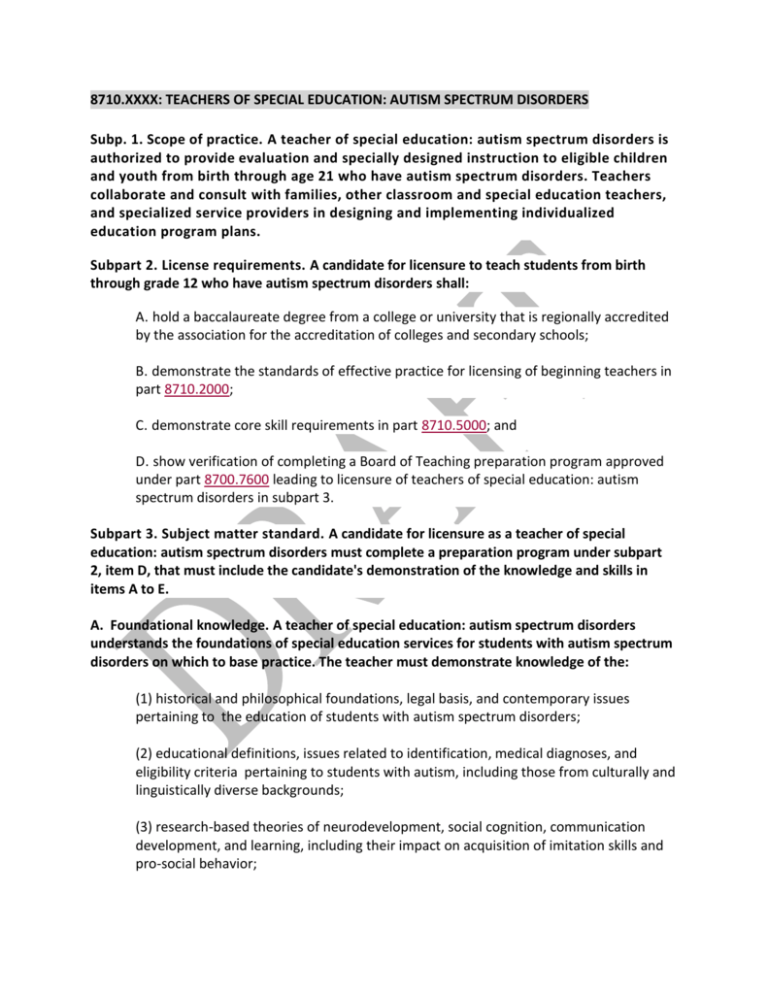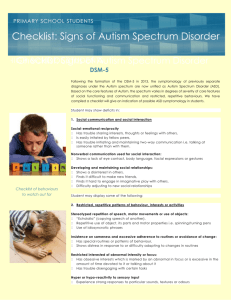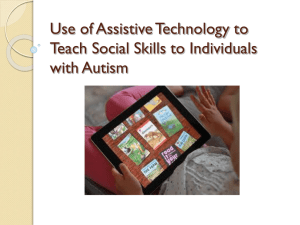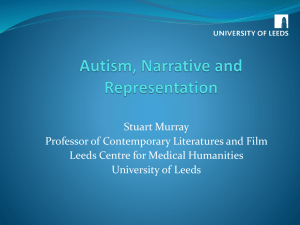ASD, June 8
advertisement

8710.XXXX: TEACHERS OF SPECIAL EDUCATION: AUTISM SPECTRUM DISORDERS Subp. 1. Scope of practice. A teacher of special education: autism spectrum disorders is authorized to provide evaluation and specially designed instruction to eligible children and youth from birth through age 21 who have autism spectrum disorders. Teachers collaborate and consult with families, other classroom and special education teachers, and specialized service providers in designing and implementing individualized education program plans. Subpart 2. License requirements. A candidate for licensure to teach students from birth through grade 12 who have autism spectrum disorders shall: A. hold a baccalaureate degree from a college or university that is regionally accredited by the association for the accreditation of colleges and secondary schools; B. demonstrate the standards of effective practice for licensing of beginning teachers in part 8710.2000; C. demonstrate core skill requirements in part 8710.5000; and D. show verification of completing a Board of Teaching preparation program approved under part 8700.7600 leading to licensure of teachers of special education: autism spectrum disorders in subpart 3. Subpart 3. Subject matter standard. A candidate for licensure as a teacher of special education: autism spectrum disorders must complete a preparation program under subpart 2, item D, that must include the candidate's demonstration of the knowledge and skills in items A to E. A. Foundational knowledge. A teacher of special education: autism spectrum disorders understands the foundations of special education services for students with autism spectrum disorders on which to base practice. The teacher must demonstrate knowledge of the: (1) historical and philosophical foundations, legal basis, and contemporary issues pertaining to the education of students with autism spectrum disorders; (2) educational definitions, issues related to identification, medical diagnoses, and eligibility criteria pertaining to students with autism, including those from culturally and linguistically diverse backgrounds; (3) research-based theories of neurodevelopment, social cognition, communication development, and learning, including their impact on acquisition of imitation skills and pro-social behavior; (5) impact of the range of neurological differences, communication, and social understanding on learning and behavior; (6) etiology, early indicators, and core and associated characteristics of autism spectrum disorders, and their impact on social interaction, communication, behavior, and learning; (7) impact of the combined effects of the restricted range of interests, limited social understanding, impaired language skills, idiosyncratic sensory behaviors, and anxiety on the student’s ability to benefit from incidental learning opportunities; and (8) impact of co-existing conditions or multiple disabilities. B. Referral, evaluation, planning, and programming. A teacher of special education: autism spectrum disorders understands and applies principles of prevention and intervening early and procedures for referral, assessment, evaluation, individualized planning, programming, and placement specific to teaching students with autism spectrum disorders The teacher must be able to: (1) select and use a range of procedures, including non-biased, autism spectrum disorders-specific assessments, to screen and complete comprehensive evaluations for autism spectrum disorders eligibility, determine educational needs, and develop and implement individualized educational plans and programs; (2) conduct and interpret functional behavioral assessments taking into account underlying autism spectrum disorders characteristics, such as sensory, social anxiety, emotional regulation, and communicative intent, and environmental factors when developing a positive behavior support plan; (3) conduct assessments of environmental conditions that impact academic achievement and functional performance, in order to accommodate student needs across settings in the planning, programming, and placement process; and (4) support the selection, acquisition, and use of assistive technology to meet the communicative and other needs of students with autism spectrum disorders in collaboration with students, families, staff, and specialists. (5) interpret and integrate evaluation results in the planning and programming process in collaboration with team members and outside agencies; (6) address factors such as gender, socio-economic status, and familial, cultural, and linguistic diversity and their relation to the evaluation, planning, and programming process for students with autism spectrum disorders; (7) identify, support, and plan for the health and safety needs of students with autism spectrum disorders in collaboration with parents and medical professionals as part of the evaluation, planning, and programming process; and (8) design individualized education program plans, considering a range of educational placement options and required levels of support in the least restrictive environment, that integrate student strengths, needs, assessment results, and student and family priorities, incorporating academic and nonacademic goals. C. Instructional design, teaching, and ongoing evaluation. A teacher of special education: autism spectrum disorders understands how to use individualized education program plans to design, implement, monitor, and adjust instruction for students with autism spectrum disorders. The teacher must be able to: (1) integrate knowledge of evidence-based instruction, including scientifically-based research interventions when available, in language development, reading, writing, and math with characteristics of autism spectrum disorders in order to design, implement, monitor, and adjust instruction aligned with grade-level content standards; (2) design, implement, monitor, and adjust evidence-based instructional methods and strategies to teach social, communication, behavioral, academic, and functional skills that are age- and ability-appropriate across environments; (3) implement, monitor, and adjust assistive technology to improve the functional capabilities and communication skills of students with autism spectrum disorders across environments as well as to promote literacy and participation in and access to the general education curriculum; (4) design, implement, monitor, and adjust instructional programs that promote social participation and interpersonal interactions by teaching social understanding, communication, problem solving skills, and self regulation skills across environments; (5) design, implement, monitor, and adjust instructional programs that take into consideration individual strengths, interests, and skills, including post-secondary transition needs; (6) design, implement, monitor, and adjust program modifications based on factors including social and emotional, sensory issues, diet, and medication and their relationship to communication, socialization, and behavior; (7) apply structured teaching methods, communication systems, and instructional and environmental modifications and accommodations to develop communication, social, and behavioral competence to promote progress in general education and other instructional settings; (8) design, implement, monitor, and adjust positive behavior plans as part of the IEP that connect challenging behavior to the lack of specific skills and teach functionally equivalent, age appropriate, alternative communication, social, behavioral, and self regulatory skills; (9) design, implement, monitor, and adjust goals and objectives addressing the core features of autism spectrum disorders in social, communication, behavior, and all other areas of complex need identified through evaluation; (10) design, implement, monitor, and adjust a range of instructional strategies that promote the generalization of skills across staff, materials, and environments; (11) make decisions about the participation of students with disabilities in the full range of state assessment options including necessary accommodations; and (12) provide sequential instruction on grade-level content standards, adjusting when necessary for breadth, depth, and complexity, for students participating in alternate assessments. D. Collaboration and communication. A teacher of special education: autism spectrum disorders cultivates and maintains positive, collaborative relationships with children and youth, families, educators, other professionals, and the community to support development and educational progress. The teacher must be able to: (1) promote peer acceptance, social participation, and achievement by training, coaching, supporting, structuring, and modeling evidence-based strategies for autism spectrum disorders to peers, parents, paraprofessionals, and other school staff; (2) provide and receive consultation and collaborate in a variety of settings regarding development and implementation of the comprehensive evaluation process, individualized education program planning, delivery of instruction and accommodations, and transition with individuals and agencies; (3) coordinate processes that encourage collaboration for transitions between settings and connect families and professionals to educational and community resources for autism spectrum disorders with school, community, social services, networks, agencies, and organizations; (4) consider the impact of core and associated characteristics of autism spectrum disorders on family dynamics and functioning and the perspectives of families and individuals with autism spectrum disorders when interacting and planning; (5) promote collaborative practices that respect the individual’s and family’s culture and values relative to the impact that autism spectrum disorders may have on the individual and family across the lifespan; (6) access information, research, and emerging practices relevant to the field of autism spectrum disorders through consumer and professional organizations, peer-reviewed journals, and other publications; and (7) engage in continuing professional development and reflection to increase knowledge and skill as a special educator and inform instructional practices, decisions, and interactions with children and youth and their families. E. Clinical experiences. A teacher of special education: autism spectrum disorders applies the standards of effective practice through a variety of early and ongoing clinical experiences in teaching children and youth with autism spectrum disorders in birth through preschool, primary (grades K-4), and secondary (grades 5-12, including transition programs) settings across a range of service delivery models. Subpart 4. Continuing licensure. A continuing license shall be issued and renewed according to rules of the Board of Teaching governing continuing licenses. Subpart 5. Effective date. The requirements in this part for licensure as a teacher of special education: autism spectrum disorders are effective September 1, 2011 and thereafter.





